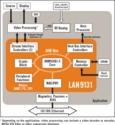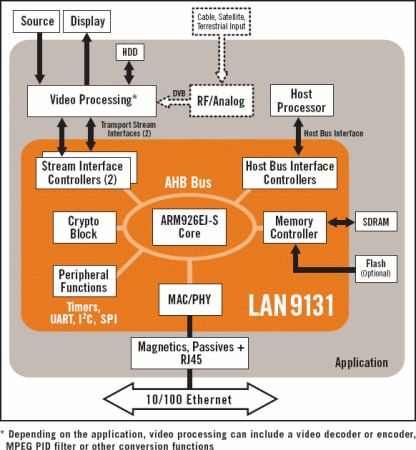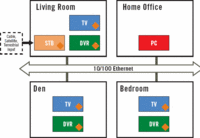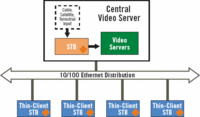“Network multimedia co-processor” chip runs Linux
Sep 19, 2006 — by LinuxDevices Staff — from the LinuxDevices Archive — 1 views Standard Microsystems Corp. (SMSC) is sampling a highly integrated chip claimed to be the industry's first “network multimedia co-processor.” The LAN9131 essentially adds a dedicated, Linux-based data-plane computer to existing and new device designs, enabling them to stream multiple high-definition (HD) channels… over 100Mb/s Ethernet, according to the company.
Standard Microsystems Corp. (SMSC) is sampling a highly integrated chip claimed to be the industry's first “network multimedia co-processor.” The LAN9131 essentially adds a dedicated, Linux-based data-plane computer to existing and new device designs, enabling them to stream multiple high-definition (HD) channels… over 100Mb/s Ethernet, according to the company.
To date, few if any consumer electronics devices have touted the capability to stream more than a single HD channel over wired 100Mb/s Ethernet. SMSC says the LAN9131 offers “the best available Fast Ethernet data rates,” however, and claims the chip can stream two HD channels, using MPEG-2 compression, or “multiple” HD channels, using MPEG-4.
Typical applications for dual HD streaming include HD TVs with “picture-in-picture” capability. Additional targeted devices include Ethernet-based video/media distribution systems, DVRs, video servers, NAS devices with built-in DLNA servers, “thin-client set-top boxes,” digital media clients/servers, and home gateways.
Expected apps include home LANs (left) and multi-user environments (right)
(Click either to enlarge)
In addition to TCP/IP processing, the LAN9131 can handle software protocol stack management and security, as well as encyption and decryption for DRM (digital rights management) applications, SMSC suggests. It can also optionally handle processing chores associated with UPnP (universal plug-and-play) and DLNA (Digital Living Network Alliance) recommendations, according to the company.
What's under the heatsink?
The LAN9131 SoC (system-on-chip) is based on a 32-bit ARM926EJ-S core, clocked at an unspecified speed. It uses an AMBA high-speed bus (AHB) to connect to on-chip functions that include dual TSIs (transport stream interfaces), a host-bus interface controller, memory controller, and various function blocks and peripherals. It can boot Linux either from locally attached flash, or from the host processor.

The LAN9131 architecture diagram
(Click to enlarge)
SMSC claims that the LAN9131 can support two HD streams using MPEG-2, or “multiple” HD streams using MPEG-4, SMSC says. However, the chip is “codec-agnostic,” the company says, and also supports WMV9/VC-1 and H.264/AVC.
Other touted features include:
- Support for UPnP protocols: HTTPU, HTTPMU, GENA, SOAP, XML and SSDP
- SMSC custom API run-time libraries and drivers for host CPU communications
- Easily interfaces to most 32- and 16-bit embedded CPU busses
- Embedded Linux OS with full support for networking applications
- Integrated 10/100 Ethernet MAC/PHY
- Supports DLNA guidelines
- Supports multiple HD video streams
- Built-in UPnP, HTTP, TCP/IP protocol stack
- Integrated 128-bit AES encryption/decryption for Digital Rights Management (DRM)
- Supports Windows Media DRM10 (WMDRM 10)
- Supports Digital Transmission Content Protection over Internet Protocol (DTCP-IP)
- Fast DTCP-IP AKE key exchange time (0.6 sec.)
- Two Transport Stream Interfaces (TSIs) to MPEG encoder/decoder SoCs
- Either interface can be used in server or rendering applications
- Video codec agnostic
- Supports MPEG2, MPEG4, WMV9/VC-1, H.264/AVC
- Integrated ARM926EJ-S core
- Integrated 10/100 MAB/PHY with HP Auto-MDIX and multiple power management modes
- TCP/UDP checksum offload
- 256-pin XTQFP package
Johson Tan, GM of connected home media at SMSC, stated, “The investments we've made in creating a home multimedia solution that works in conjunction with existing System-on-Chip (SoC) processor environments will enable designers to get to market fast with high-performance systems that support multiple HD streams. The ease of design, low development risk and reduction of overhead make it possible for designers to virtually 'plug in' the system while still adopting key functionality such as encryption/decryption.”
Availability
The LAN9131 engineering samples are available today. Qualification samples are expected to be available in December 2006, with mass production samples in the first quarter of calendar 2007.
This article was originally published on LinuxDevices.com and has been donated to the open source community by QuinStreet Inc. Please visit LinuxToday.com for up-to-date news and articles about Linux and open source.

